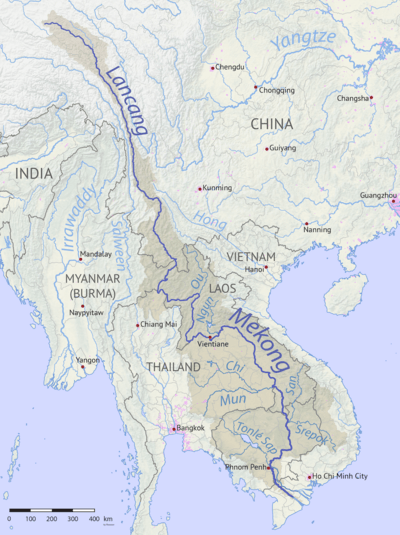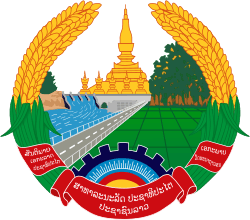Energy in Laos
This page describes energy and electricity production, consumption and import in Laos.
Hydropower

In 2010, The Lao People's Democratic Republic requested the Mekong River Commission[1] (MRC) to approve their petition of 11 proposed dams.This notion began after the country's intentions of becoming the "Battery of Southeast Asia", as Laos currently exports an estimated two-thirds of its hydropower.[2] This goal can be attributed to the geographical region of Laos being situated in the lower Mekong Basin (LMB), which includes a 35% of Mekong's total inflows. According to the Strategic Environmental Assessment (SEA) of the MRC, if the proposed dams are built, they will generate 15,000 MW of power, which is projected to fill 8% of the regional demand by 2025. Additionally, the SEA reports hydropower in Laos can result in a gross income of $3.8 billion per year.[3] With the SEA research, the Lao government's decision to develop hydropower plants is explained by its economic benefit. The Lao Government has ongoing plans for 50+ new hydropower plants for electricity export.[4] However, hydropower development may have large environmental and social consequences beyond national borders. Non-governmental organizations such as International Rivers has raised concerns over these developments in the Mekong.[5][6][7]
Xayaburi Dam
The $3.8bn (£2.4bn) hydro-electric dam project at Xayaburi Dam has caused tension among Mekong region countries - Laos, Vietnam, Cambodia and Thailand. In April 2012 a contract was signed for a Thai company, CH Karnchang, to build the dam. The Lao government has pledged to resolve the environmental issues.[8] The government says two big issues - fish migration and sediment flow - will be addressed. Critics say the hydro-electric dam project at Xayaburi would harm the river's eco-system.[9]
Finnish engineering firm Pöyry supported the Lao government in the hydropower construction e.g. by argument that no international agreement is needed. Pöyry Engineering supported in 2012 in Laos Mekong river Xayabar hydropower plant that was opposed at least by Cambodia, Vietnam and environmental and other non-governmental organisations. Pöyry admitted it had not assessed all environmental risks (fish, ecosystem). According to Pöyry they have no responsibility of their reports: Olemme pelkkä konsultti. “We only consult” it said in June 2012.[10]
The aim was to supply electricity mainly to Thailand by a Thai company and to provide export income to the government of Laos. However, the Mekong River Commission recommended suspending the project. According to Finnish media the Finnish government is among the main financiers of the river commission. As of 2012, the Mekong river downstream is free of dams. Approximately 60 million people live in the area in Laos, Vietnam and Cambodia. Then-U.S. Secretary of State Hillary Clinton visiting the ASEAN countries in July 2012 demanded environmental investigations of the project. During her visit, the Lao government made the first official announcement to suspend the project.[11]
Natural History of the Mekong River Basin
Geography

The Mekong River is the largest river in Southeast Asia, with a length of 4,350 km flowing through six countries: China, Myanmar, Thailand, Lao PDR, Cambodia, and Vietnam. The Mekong River Basin encapsulates a large area and can be defined into 7 physiographic regions: Tibetan Plateau, Three Rivers Area, Lancang Basin, Northern Highlands, Khorat Plateau, Tonle Sap Basin, and the Mekong Delta. The Tibetan Plateau, Three Rivers Area and Lancang Basin form the Upper Mekong Basin while the Northern Highlands, Khorat Plateau, Tonle Sap Basin and Mekong Delta make up the Lower Mekong Basin.[12] Laos is situated within the Lower River Basin, which has a catchment of 25% of the MRB -- approximately 202,000 km2 of water. The region of Laos contains 35% of Mekong's total inflows. [13]
Resources
The Lower Mekong Basin provides a wide range of benefits: drinking water, freshwater food supplies, biodiversity hotspots, agricultural irrigation, transport, and industrial uses (such as hydropower development). The Tonle Sap region of Cambodia, the largest freshwater lake in Southeast Asia, is critical for food security as it provides areas for agriculture and aquaculture in the surrounding wetlands and flooded forests. This region is the center of Cambodia's fishing industry and rice fields on which 40% of the population depend. Additionally, the Tonle Sap region consists of a variety of habitats and biomes, resulting in an area of biodiversity. Another region of the Lower Mekong Basin is the Mekong delta, a resource vital to Vietnam's rice production -- the world's second largest exporter of rice. [14]
Environmental Effects of Hydropower
Impacts on the fish life cycle
The construction of dams in the Mekong Basin greatly impact the fish migration and local fisheries. Generally, the development of a hydropower dam results in altered flow patterns and creates a large physical barrier, thus disrupting the fish and their breeding habitats within the river. This is particularly impactful in the Mekong as 40-70% of fish catch is from migrating species, where most hunted fish can potentially fail to reach historic fishing areas with dams impeding upstream migration. Looking at a 2008 study of Hydropower dams in the Lower Mekong Basin, planned dams will have a major impact on fisheries and "disrupt upstream migration of economically and biologically important species"[15]. Additionally, the downstream drift of fish eggs that sustain lower fisheries will be blocked by the construction of dams. Trying to apply modern solutions to fish passage can partially mitigate the impact; however, the scale of fish migration on the Mekong stream involves over 50 different species which current methods cannot support.[15][16] With the addition of more and more hydropower dams, local fisheries must adapt to different flow conditions and act according to unexpected flooding events with the potential to wash away assets.[17]
Impacts to Mekong's Sediment
With Laos planning over 50+ dams on the Mekong and its tributaries, the physical barrier Hydropower dams possess disturbs the natural sediment flow downstream. This barrier can cause certain areas' water level to rise and creates a trap for sediment behind walls. Investigations note 26,400 tons of nutrient is sent into the Mekong floodplains per year through sediment loads.[18] With dams in place, the floodplains and agricultural lands that are reliant on a certain level of sediment will be deprived. A report by the International Center for Environmental Management suggest, "current nutrient load will be reduced by seventy-five percent by 2030" if all proposed dams are built. A block to nutrient-carrying sediment sets off a chain reaction that will inevitability impact all nations downstream, lowering food security and putting millions of livelihoods at risk. [19]
Impacts on Human Development
The continual development of Hydropower has positive effects such as flood control, irrigation, and river navigation; conversely, the development of Hydropower plants can negatively affect the 3 million Laotians relying on the Mekong for livelihood and food security. With dams blocking the migration of fish, many communities will experience a loss of fish population. Over the last few years, the development of hydropower dams have caused a 10-20% population loss while during a period of 2001-2003, the Thai-Lao border showcased a 50% catch decrease, greatly affecting local communities and their livelihood.[20] With the hydrology of the Lower Mekong forcefully altered, agricultural lands will experience a new river regime -- variability in its discharge -- that can negatively affect farms. The most notable change for the population near the Mekong is the loss of agricultural land due to flooding from hydropower dams. Flooding can cause a loss of crop, productivity, livestock. With an increase of floods near agricultural land there can be a loss of nutrition, an input to the productivity of nearby agriculture.
The rural communities of a riparian country like Laos rely heavily on fishing for food security.[21] Hydropower development affecting the migration of fish and productivity of fisheries are a great threat to food security. Local communities are not the ones impacted, a study done by the Mekong River Commission showcased, "Fisheries do not only benefit the people living next to the river or the floodplains, but all of the Lower Mekong Basin countries."[22] Hydropower development indirectly impacts human development on many scales.[20]
Power companies
Power companies responsible for energy and electricity production in Laos include: Electricite du Laos, Glow Energy (a subsidiary of GDF Suez), Lao Holding State Enterprise and Nam Theun 2 Power Company, a consortium comprising French-owned EDF (40% ownership), Thai (35%) and Lao (25%) entities.
See also
References
- MENON, P. K. “The Mekong River and International Development of Natural Resources.” The International Lawyer, vol. 5, no. 1, 1971, pp. 53–58. JSTOR, www.jstor.org/stable/40704644.
- "Laos | International Hydropower Association". www.hydropower.org. Retrieved 2019-03-11.
- "Strategic Environmental Assessment of Mainstream Dams » Mekong River Commission". www.mrcmekong.org. Retrieved 2019-03-11.
- "Greater Mekong Dams Observatory | WLE Mekong". Retrieved 2019-03-25.
- Virta vie mua , Pöyry: Mekongin vesikonfliktin asekauppias? Voima (newspaper) June 2012 page 44 (in Finnish)
- "Laos". International Rivers. Retrieved 2017-01-12.
- Grumbine, R Edward, et al. “Mekong Hydropower: Drivers of Change and Governance Challenges.” Frontiers in Ecology and the Environment, vol. 10, no. 2, 2012, pp. 91–98. JSTOR, www.jstor.org/stable/41480006.
- US Secretary of State Hillary Clinton on historic Laos visit BBC 11 July 2012
- Laos vows to address concerns over Mekong river dam 6 July 2012
- Virta vie mua , Pöyry: Mekongin vesikonfliktin asekauppias? Voima (newspaper) June 2012 page 44 (in Finnish)
- Laos ilmoitti kiistellyn patohankkeen siirtämisestä - Suomi rahoittanut selvityksiä yle 13.7.2012 (in Finnish)
- "physiographic regions". Mekong River Commission.
- Mekong River Commission (2005). "Overview of the Hydrology of the Mekong Basin" (PDF). MRC, Vientiane, Laos.
- "physiographic regions". Mekong River Commission.
- Dugan, P. (2008). "Mainstream dams as barrier to fish migration: International learning and implications for the Mekong". Catch and Culture. 14: 9–15 – via JSTOR.
- Dugan, Patrick J., et al. “Fish Migration, Dams, and Loss of Ecosystem Services in the Mekong Basin.” Ambio, vol. 39, no. 4, 2010, pp. 344–348. JSTOR, www.jstor.org/stable/40928394.
- Pearse-Smith; Scott William (2012). "The Impact of Continued Mekong Basin Hydropower Development on Local Livelihoods". Consilience. 7: 73–86.
- ICEM (International Centre for Environmental Management). (2010a). Strategic Environmental Assessment of Hydropower on the Mekong Mainstream. Hanoi, Viet Nam: Mekong River Commission. Retrieved from http://www.mrcmekong.org/ish/SEA/SEA-Main-Final-Report.pdf.
- Pearse-Smith, Scott William David. “The Impact of Continued Mekong Basin Hydropower Development on Local Livelihoods.” Consilience, no. 7, 2012, pp. 73–86. JSTOR, www.jstor.org/stable/26167837.
- Pearse-Smith, Scott William David. “The Impact of Continued Mekong Basin Hydropower Development on Local Livelihoods.” Consilience, no. 7, 2012, pp. 73–86. JSTOR, www.jstor.org/stable/26167837.
- ICEM (International Centre for Environmental Management). (2010a). Strategic Environmental Assessment of Hydropower on the Mekong Mainstream. Hanoi, Viet Nam: Mekong River Commission. Retrieved from http://www.mrcmekong.org/ish/SEA/SEA-Main-Final-Report.pdf.
- Sarkkula, J (2009). "Hydropower in the Mekong Region: What are the likely impacts upon fisheries?". Contested waterscapes in the Mekong region: pg 227-252.
